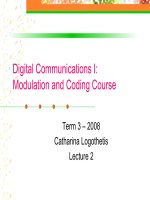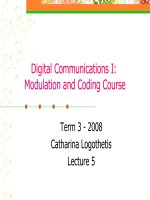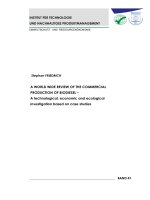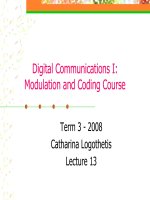decusatis, c. (2001). fiber optic data communication - technological trends and advances
Bạn đang xem bản rút gọn của tài liệu. Xem và tải ngay bản đầy đủ của tài liệu tại đây (13.36 MB, 590 trang )
F-'
@
ic
P
DATA
COMMUNICATION
Technological Trends and Advances
0
r
3
I
I
r
FIBER OPTIC DATA COMMUNICATION:
TECHNOLOGICAL TRENDS AND ADVANCES
FIBER OPTIC
DATA COMMUNICATION:
TECHNOLOGICAL TRENDS
AND ADVANCES
CASIMER
DeCUSATIS
Editor
IBM
Corporation
Poughkeepsie,
New
York
ACADEMIC
PRESS
An
Elsevier
Science
Imprint
San
Diego
London
Boston
New
York
Sydney
Tokyo
Toronto
This
book is printed on acid-free paper.
@
Copyright
0
2002,1998
by Academic Press
All
rights reserved.
No part of
this
publication may be reproduced or transmitted in any
form
or by any means,
electronic or mechanical, including photocopy, recording, or any information storage and
retrieval system, without permission
in
writing from the publisher.
Requests for permission to make copies of any part of the work should be mailed
to
the fol-
lowing address: Permissions Department, Harcourt, Inc.,
6277
Sea Harbor Drive, Orlando,
Florida
32887-6777.
The appearance of the code at the bottom of the fist page of a chapter
in this
book indicates
the Publisher’s consent that copies
of
the chapter may be made for personal or internal use
of specific clients. This consent is given on the condition, however, that the copier pay the
stated per copy fee through the Copyright Clearance Center, Inc.
(222
Rosewood Drive,
Danvers, Massachusetts
01923),
for copying beyond that permitted by Sections 107 or
108
of the
U.S.
Copyright Law. This consent does not extend
to
other kinds of copying, such
as copying for general distribution, for advertising or promotional purposes, for creating
new collective works, or for resale. Copy fees for pre-2002 chapters
are
as
shown
on
the
title pages.
If
no fee code appears on the title page, the copy fee is the same
as
for current
chapters.
$35.00
Explicit permission from Academic Press is not required to reproduce a maximum
of
two
figures or tables from an Academic Press chapter in another scientific or research publication
provided that the material has not been credited to another source and that full credit to the
Academic Press chapter is given.
ACADEMIC
PRESS
An Elsevier Science Imprint
525 B
Street, Suite
1900,
San Diego, CA
92101-4495,
USA
ACADEMIC
PRESS
LIMHTD
An
Elsevier Science Imprint
Harcourt Place,
32
Jamestown Road, London
NW17BY,
UK
Library
of
Congress
Catalog
Card
Number:
2001095439
International Standard
Book
Number:
0-12-207892-6
Printed in China
02 03
04
05
RDC
9
8
7 6
5
4
3
2
1
To
the people
who
give meaning to my life
and taught me to
look
for
wonder
in
the
world:
my wife, Carolyn, my daughters, Anne and Rebecca, my parents,
my godmother, Isabel, and her mother,
Mrs.
Crease.
-
CD
Con
tents
Contributors
Preface
xi
xiii
Part
1
Technology Advances
Chapter
1
History
of
Fiber Optics
Jeff
D.
Montgomery
1.1.
Earliest Civilization to the Printing
Press
1.2. The Next
500
Years: Printing
Press
to
Year
2000
1.3. Fiber Optic Communication Advancement, 1950-2000
1.4. Communication Storage and Retrieval
1.5. Future of Fiber Optic Communications, 2000-2050
References
Chapter
2
Market Analysis
and
Business Planning
Yann
E
Moman
and
Ronald
C.
Lasky
2.1. Introduction
2.2. The Need for Applications
2.3. Supporting Technology Infrastructure
2.4. Implementing a Market Survey
2.5.
Business Planning
2.6. Summary
Appendix: Market Analysis
on
a
Transmitter
Optical Subassembly
Industry Description and Outlook
World Fiber Optics Industry
Target Markets
Competition
Position
Conclusion
References
3
3
5
9
17
22
31
32
32
32
33
34
37
41
42
42
45
48
58
60
61
62
vii
viii
Contents
Chapter
3
Small Form Factor Fiber Optic Connectors
John
Fox
and Casimer DeCusatis
3.1.
3.2.
3.3.
3.4.
3.5.
3.6.
3.7.
3.8.
Introduction
MT-RJ Connector
SC-DC Connector
VF-45 Connector
LC Connector
Other Types
of
SFF
Connectors
Transceivers
SFF
Comparison
References
Chapter
4
Specialty Fiber Optic Cables
Casimer DeCusatis and John
Fox
4.1.
4.2.
4.3.
4.4.
4.5.
4.6.
4.7.
4.8.
4.9.
Introduction
Fabrication of Conventional Fiber Cables
Fiber Transport Services
Polarization Controlling Fibers
Dispersion Controlling Fibers
Photosensitive Fibers
Plastic Optical Fiber
Optical Amplifiers
Futures
References
Chapter
5
Optical Wavelength Division Multiplexing
for Data Communication Networks
Casimer DeCusatis
5.1. Introduction and Background
5.2. Wavelength Multiplexing
5.3. Commercial
WDM
Systems
5.4. Intelligent Optical Internetworking
5.5.
Future Directions and Conclusions
References
Chapter
6
Optical Backplanes,
Board
and Chip Interconnects
Rainer Michalzik
6.1. Introduction
6.2. Frame-to-Frame Interconnections
6.3. Optical Backplanes
63
63
64
68
71
74
77
79
80
87
89
89
89
98
111
114
119
120
123
125
131
134
134
140
170
192
207
21
1
216
216
219
230
Contents
6.4.
Optical
Board
Interconnects
6.5.
Optical Chip Interconnections
6.6.
Conclusion
References
Chapter 7 Parallel Computer Architectures Using Fiber Optics
David B. Sher and Casimer DeCusatis
7.1.
Introduction
7.2.
Historical and Current Processors
7.3.
Detailed Architecture Descriptions
7.4.
Optically Interconnected Parallel Supercomputers
7.5.
Parallel Futures
References
Part
2
The
Future
Chapter
8
Packaging Assembly Techniques
Ronald C.
Lusky,
Adam Singes and Prashant Chouta
8.1.
Packaging Assembly
-
Overview
8.2.
Optoelectronic Packaging Overview
8.3.
Component Level Optoelectronic Packaging
8.4.
Module Level Optoelectronic Packaging
8.5.
System Level Optoelectronic Packaging
References
Chapter
9
InfiniBand-The Interconnect from Backplane to Fiber
Ali Ghiasi
9.1.
Introduction
9.2.
Infiniband Link Layer
9.3.
9.4.
Optical Specifications
9.5.
Optical Receptacle and Connector
9.6.
Fiber Optic Cable Plant Specifications
References
Optical Signal and Jitter Methodology
Chapter
10
New Devices for Optoelectronics:
Smart
Pixels
Barry
L.
Shoop, Andre
H.
Sayles, and Daniel
M.
Litynski
10.1.
Historical Perspective
10.2.
Multiple Quantum Well Devices
ix
241
246
255
256
270
270
274
283
296
298
299
303
303
315
316
317
318
320
32
1
321
322
326
334
345
349
35
1
352
353
354
10.3.
Smart Pixel Technology
359
x
Contents
10.4. Design Considerations
10.5. Applications
10.6. Future Trends and Directions
Chapter
11
Emerging Technology for
References
Fiber Optic Data Communication
Chung-Sheng
Li
1 1.1. Introduction
11.2. Architecture
of
All-Optical Network
11.3. Tunable Transmitter
11.4. Tunable Receiver
11.5. Optical Amplifier
1
1.6. Wavelength
MultiplexerDemultiplexer
1 1.7. Wavelength Router
1 1.8. Wavelength Converter
11.9.
summary
References
Chapter
12
Manufacturing Challenges
Eric
Maass
12.1. Customer Requirements
-
Trends
12.2. Manufacturing Requirements
-
Trends
12.3. Manufacturing Alternatives
Appendix
A
Measurement Conversion Tables
Appendix
B
Physical Constants
Appendix
C
Index of Professional Organizations
Appendix
D
OS1
Model
Appendix
E
Network Standards and Documents
Appendix
F
Data Network Rates
Appendix
G
Other Datacom Developments
375
381
409
410
422
422
424
426
429
433
436
437
440
443
443
447
447
450
479
486
488
489
49
1
492
495
505
Acronyms
Glossary
Index
511
529
555
Contributors
Numbers in parentheses indicate the pages
on
which the authors
’
contributions begin.
Prashant Chouta
(303), Cookson Performance Solutions, 25 Forbes Boulevard,
Casimer DeCusatis
(63,89,134,270), IBM Corporation, 2455
South
Road MS
John
Fox
(63, 89), Computercrafts, Inc., 57 Thomas Road, Hawthorne, New
Ali
Ghiasi
(321), Broadcom Corporation (formerly SUN Microsystems), 19947
Ronald C. Lasky
(32,303), Consultant, 26 Howe Street, Medway, Massachusetts
Chung-Sheng Li
(422), IBM Thomas
J.
Watson Research Center, 30 Sawmill
River Road, Hawthorne, New York 10532
Daniel M. Litynski
(352), College of Engineering and Applied Sciences, Western
Michigan University, 2022 Kohrman Hall,
Kalamazoo,
Michigan 49008
Eric
Maass
(447), Motorola, Incorporated, 2100 Elliot Road, Tempe, Arizona
85284
Rainer Michalzik
(2 16), University
of
Ulm, Optoelectronics Dept., Albert-Einstein-
Jeff D. Montgomery
(3), ElectroniCast Corporation, 800
South
Claremont St.,
Yann Y. Morvan
(32), Cookson Electronics, New Haven, Connecticut, 06510
Foxborough, Massachusetts 02053
P343, Poughkeepsie, New York 12601
Jersey 07507
Linden Brook Lane, Cupertino, California 95014
02053
Allee 45, D-89069 Ulm, Germany
San Mateo, California 94402
Xi
xii
Contributors
Andre
H.
Sayles
(352), Photonics Research Center and Department
of
Electrical
Engineering and Computer Science,
U.S.
Military Academy, West Point, New
York 10996
David
B.
Sher
(270),
MathematicdStatisticdCMP
Dept., Nassau Community
College, 1 Education Drive, Garden City, New York
11530
Barry
L.
Shoop
(352), Photonics Research Center and Department
of
Electrical
Engineering and Computer Science,
U.S.
Military Academy, West Point, New
York 10996
Adam Singer
(303), Cookson Performance Solutions, 25 Forbes Boulevard,
Foxborough, Massachusetts 02053
“I
have traveled the length and breadth
of
this country and talked with the
best people, and
I
can assure
you
that data processing is a fad that won’t
last out the yeal:”
-Attributed to the chief editor for business
books,
Prentice Hall,
1957
“There is nothing more dificult to take in hand, more perilous to conduct,
or
more uncertain in its success, than to take the lead in the introduction
of
a new order
of
things.”
-Machiuvelli
This book arose during the process of revising the second edition of the
Handbook of Fiber Optic Data Communication, when it became apparent
that one book wasn’t enough to contain
all
of the technology develop-
ments in wavelength multiplexing, optically clustered servers, small form
factor transceivers and connectors, and other emerging technologies.
As
a
result, we decided to split
off
the four chapters on futures from the original
handbook, combine them with many new chapters, and form this book,
which can serve as either a companion to the original book
or
a stand-alone
reference volume.
Many new chapters have also been added to address the rapidly accel-
erating rate
of
change that has characterized this field. New component
technologies for optical backplanes, parallel coupled computer architec-
tures, and smart pixels are among the topics covered here. Open standards,
which to a great extent have created the Internet and the Web (remem-
ber
TCPDP?)
also
continue to evolve, and new standards are emerging
to
deal with the requirements
of
the next generation intelligent optical in-
frastructure; some
of
these standards, such as Infiniband, are covered in
this volume. There are also new chapters on the history
of
communica-
tions technology (with apologies to those who have noted that it remains
xiii
xiv
Preface
difficult to determine exactly who invented the first one of anything, and
that the history of science is filled with tales of misplaced credit), and pre-
dictions of the future, as envisioned by some of the leading commercial
technology forecasters. Given the rapid and accelerating rate of change in
this
field, it is inevitable that some topics of interest will not be covered.
As this book goes to press, for example, there is growing interest in micro-
electromechanical devices (MEMs) and so-called micro-photonics, ultra
high data rate transceivers
(40
Gbit/s and above), advanced storage area
networks and network attached storage, and other areas that
are
beyond the
scope of
this
text. It is our hope that these and other topics will be incor-
porated into future editions of
this
book, just as the original Handbook of
Fiber Optic Data Communication has grown through the years.
An undertaking such
as
this
would not be possible without the concerted
efforts of many contributing authors and a supportive staff at the publisher,
to all of whom
I
extend my deepest gratitude. The following associate
editors contributed to the first edition of the Handbook of Fiber Optic
Data Communication: Eric
Maass,
Darrin Clement, and Ronald Lasky.
As
always, this book is dedicated to my parents, who first helped me see the
wonder in the world;
to
the memory of my godmother Isabel; and to my
wife, Carolyn, and daughters Anne and Rebecca, without whom this work
would not have been possible.
Dr. Casimer DeCusatis, Editor
Poughkeepsie, New York
Part
1
Technology
Chapter
1
Jeff
D.
Montgomery
Chainnan/Foundel; EIectroniCast
Corporation,
San
Mateo,
California
94402
History
of
Fiber
Optics
In
this review of the history of communication via fiber optics, we examine
this relatively recent advancement within the context of communication
through history. We
also
offer projections of where this continuing ad-
vancement in communication technology may lead
us
over the next half
century.
1.1.
Earliest Civilization
to
the Printing Press
1.1.1.
COMMUNICATION THROUGH THE AGES
All species communicate within their group. The evolution of the human
species, however, appears to have been much more rapid and dramatic than
the evolution of other species.
This
human advancement has coincided
with an increasingly rapid advancement
in
communication capability.
Is
this merely a coincidence, or is there a causal relationship?
The earliest human communication, we assume, was vocal; a capability
shared by numerous other species. Archaeological information, however,
indicates that, tens of thousands of years ago, humans
also
began to commu-
nicate via stored information in addition
to
the vocal mode. Cave paintings
and cliffside carvings have survived over time, to now, conveying informa-
tion that at the time was useful. Findings also indicate signal fires existed
in those early times,
to
transmit (via light) information, presumably the
3
FIBER OPTIC DATA COMMLTNICATION
Copyright
0
2002
by
Academic
Press.
TECHKOLOGICAL
TRENDS
Ah?)
ADVANCES All
rights
of
reproduction in
any
form
reserved.
$35.00
ISBN:
0-12-207892-6
4
Jeff
D.
Montgomery
sighting of the approach of other humans, the appearance of game
animals,
or other intelligence. Smoke signal communication emerged along with
nautical signal flags, followed by light-beam and flag semaphores.
As civilization advanced (and humans apparently became much more
numerous), communication became increasingly complex. Symbols
to
rep-
resent items of interest were conceived and adopted. Techniques were de-
veloped to carve these symbols in stone, or
to
paint them onto media such as
walls or sheets made from papyrus reeds
-
the early communication stor-
age media. The papyrus-enscribed messages were especially significant, in
that they were transportable
-
the early telecommunication (“communi-
cation at a distance”).
While the development of symbols and media was a major advancement,
there were still some major handicaps. Carved messages, in particular, had
very low portability. A more general problem was that forming the
sym-
bols into the media was a high-level skill that required years of training.
Kings and common people could not write (and, in general, could not read).
Beyond the limited number
of
scribes available, and the relatively high cost
per message inscribed, was the time required to complete a message; hours
to days for a simple scroll; lifetimes for stone carvings. Also, each copy,
if
wanted, required as much effort and time
as
the original. These general
techniques, however, did not change dramatically over a span of thousands
of years. A degree of “shorthand” symbols were developed for commercial
messages, and the language became richer through development of more
and increasingly refined symbols. Still, it remained a slow form of com-
munication, limited to royalty, wealthy merchants, military leaders, and
scholars.
As the need for copies of messages, such as distribution of proclamations,
increased, entrepreneurs developed the technique of transferring a symbolic
message from the original by applying ink and transferring the message
to another surface. Printing! Naturally, as this technique evolved, message
originators also evolved to sending out more copies. There also naturally
evolved a tendency to create longer, more complex messages.
So,
although
making multiple copies became feasible, crafting the original print master
remained the role of a master craftsman and, as messages became longer,
more time was required.
Within this period, some messages became long enough to be “books.”
Creating the print master for a book occupied a crew
of
engravers for
many years. Although communication certainly was advancing, it remained
expensive and slow to initiate in transportable, storable form.
1.
History
of
Fiber
Optics
5
1.2.
The Next 500 Years:
Printing
Press to Year
2000
1.2.1.
PRINTING PRESS CHANGES THE RULES
The invention of the movable-type printing press by
J.
Gutenberg, circa
1450, was a major breakthrough. By
this
time, the language of communi-
cation had evolved from pictorial symbols to words formed from a set of
characters or other symbols. These were laboriously engraved into printing
plates, requiring days to years per plate. With the availability of movable
type pieces that could be arranged to construct a clamped-together plate,
the time to create a plate was reduced by orders of magnitude; from days
to minutes. Of equal importance, the plates could now be constructed by a
technician having relatively modest training, instead of by a skilled artisan
with years of training and apprenticeship. With the Gutenberg press, the
cost of books could be greatly reduced, becoming financially available
to a much larger segment of the populace. Over the ensuing
400
years,
instruction books became widely available to
all
students, current news
publication flourished, and entertainment books emerged.
1.2.2. THE CASCADE
OF
INVENTION
With the evolution of the printing press, the worldwide exchange of in-
formation between scholars, inventors, and other innovators accelerated.
Especially over the most recent two centuries, significant inventions cas-
caded, often standing on the shoulders of earlier inventions. Some of the
key inventions related to the advancement of communication are noted in
Fig.
1.1.
Signal transmission through space by electromagnetics (Marconi),
electrical conductance principles (Maxwell), mechanized digital comput-
ing (Babbage), the telephone (Bell) were landmark inventions that set the
platforms for the just-completed Magnetic Century. Vacuum tube ampli-
fiers and rectifiers emerged, making radio transmission and reception fea-
sible (and, ultimately, ubiquitous and affordable). Electronic computing
evolved, mid-century, from an interesting intellectual concept to become a
tool,
albeit very expensive, for controlling massive electrical power grids
and for tackling otherwise overwhelmingly challenging scientific calcula-
tions. (It was visualized that several of these machines, perhaps dozens,
might ultimately be useful worldwide; Thomas
J.
Watson, International
Business Machines Chairman, postulated a potential worldwide market for
perhaps five of their computing machines.)
G.
Mamni
Long
Distance
EM
Transmission
Experiments
1894-1901
'Electranlc
Valves"
1910
Cbries
Babbaqg
b
Computing
Difference
Engine
b
18.32
James Maxwell
b
explained
"Electric
Fluid"
1860
GA
Hockham,
Sn,
Proposed
EM
transmission
on fiber,
1966
A.
G.
Bell
Telephone
Strwaer
Switch
J.
Gutenbe
PrinUng
Appx.
1450
1890
-
19SoS
I I
I
I
I
I
1
I
I
I
1
I
I
I
I
I I
I
I I
I
I
1450
7800
7820
1840
7860
1880
1900 1920
1940
1980
4980
2000
Fig.
1.1
The
electmmagnetic
century.
Uectronic
Carnpukys
Radio, Television, Microwave
Ovens
-
b
1.
HistoryofFiberOptics
7
Over the 1633-1882 span, mechanical computation machines were of
continuing interest, with concepts developed by Pascal, Leibnitz, and
Schickhard, culminating in the first serious effort to build a mechani-
cal calculator machine (by Charles Babbage, in 1882). The first work-
ing electromechanical calculator was built by IBM engineers in 1930 (the
IBM
Automatic Sequence Controlled Calculator, Mark
I),
under the
di-
rection of Professor Aiken of Harvard University.
[l]
The first electronic
calculator, ENIAC, was built by Eckert and Mauchly, of the University of
Pennsylvania, in 1946.
The Strowger switch, invented within Bell Laboratories, illustrates a sig-
nificant point that keeps recurring in the evolution of communication (and
in other fields): When a problem evolves and advances to the point that it
threatens the continuing evolution
of
an
important field, inventive minds
find a feasible solution. The early wire-line telephone systems required
switching, to connect a specific originating telephone to the desired other
telephone instrument.
This
was done by
an
operator who received verbal
instructions from the originator, then plugged a connection cord between
the two appropriate receptacles
on
the switchboard. As the number of sub-
scribers and the number of calls per subscriber steadily increased, it became
apparent that within a relatively few years it would no longer be feasible
to recruit enough operators to do the switching. Thus, the Strowger switch,
doing the same task based on telephone-number-based electrical signals,
was developed. This switch occupied a lot less physical space, and did the
task faster, at less cost, and with higher 24-hour-per-day dependability and
accuracy. The Strowger switch, introduced in the late 1800s, bridged the
transition into the Electromagnetic Century.
The advancement
of
telecommunication technology and facilities was
especially dramatic through the first half of the 20th century. Telephone
communication advanced from two-wire lines to hundreds of parallel voice
grade lines, as illustrated in Fig. 1.2, colliding with another roadblock. The
number of open, uninsulated lines routed along city streets and into major
office buildings approached the physical space limits. This drove network
developers to evolve
to
“twisted pair” insulated copper wires that greatly
reduced the space required for transmission lines. (This was followed
by
the development of coaxial cables, which could transmit hundreds of voice
signals multiplexed onto a single cable.)
This evolved to large cables, “flexible as a sewer pipe,” enclosing hun-
dreds of twisted pairs plus several coaxial cables. Most of
this
cable, in-
stalled from about 1930 to date, is still in operation, mainly in metropolitan
8
Jeff
D.
Montgomery
Two-wire Phone
,:::-:
1910
Hundreds-wires Phone
1
U
1930
1
I
Microwave Relay
I
Twisted-pairs Copper Cable
1
1940
1955
Fig.
1.2
Communication transport 19th-century evolution.
access networks in North America, Europe, and Japan, and still used for
long-haul trunk lines in less developed countries.
World War
I1
interrupted the deployment of civilian communication net-
works, especially through 1940- 1945. Paradoxically, however, this global
conflict accelerated the technology of microwave technology, deployed ini-
tially primarily in radar systems. Rocket vehicle technology also advanced
dramatically during this relatively brief interval. With the return to peace-
time priorities, point-to-point microwave communication relay products
evolved from the radar components base. Led by AT&T, General Electric,
and RCA, microwave picked up a large and rapidly increasing share of the
long-haul transcontinental telecommunication transport,
Terrestrial microwave relay communication expanded rapidly, but was
limited by radio-frequency spectrum space availability, and
also
by the re-
quirement for line-of-sight transmission. The microwave free space trans-
mission beams also spread, as
a
function of the antenna dimensions (in
wavelengths) and of the distance traversed, limiting networks to links of
a few tens of miles. Fortunately, as terrestrial microwave relay became in-
creasingly limited in expansion, especially in the most-developed regions,









